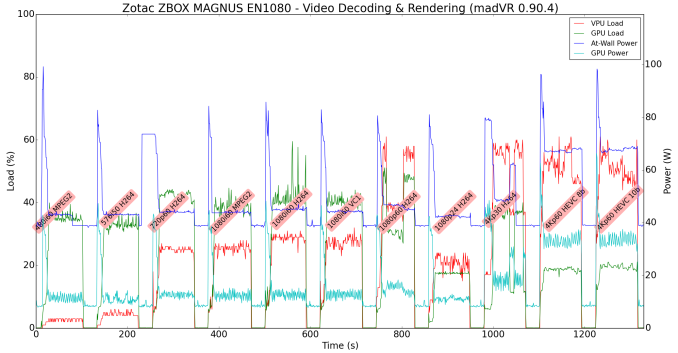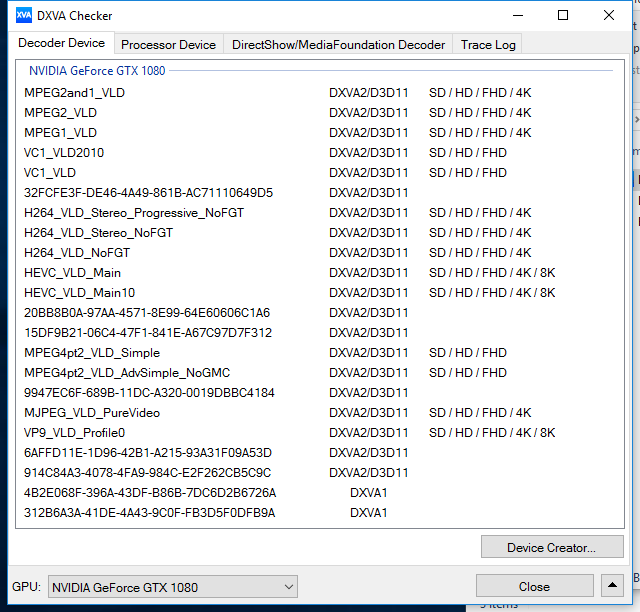Zotac ZBOX MAGNUS EN1080 SFF PC Review: A Premium Gaming Powerhouse
by Ganesh T S on December 19, 2016 8:30 AM ESTHTPC Credentials
The ZBOX MAGNUS EN980 impressed us with its noise profile for HTPC duties. The ZBOX MAGNUS EN1080 takes it one step further. The fan curves have been altered due to better power management from the GPU. The end result is that the noise profile is even better than that of the EN980. Liquid cooling enables the fans to operate at very low speeds compared to the regular heat sink and blower combinations used in other mini-PCs. Obviously, the unit is not for the discerning HTPC enthusiast who is better off with a passively cooled system. Its acoustic profile doesn't do any disservice to the EN1080's chances of being used as a gaming HTPC.
Refresh Rate Accuracy
Starting with Haswell, Intel, AMD and NVIDIA have been on par with respect to display refresh rate accuracy. The most important refresh rate for videophiles is obviously 23.976 Hz (the 23 Hz setting). As we have come to expect from NVIDIA, the default refresh rate accuracy is not that great, though they do allow fine-tuning of the refresh rate unlike other GPU vendors.
The gallery below presents some of the other refresh rates that we tested out. The first statistic in madVR's OSD indicates the display refresh rate.
Network Streaming Efficiency
Evaluation of OTT playback efficiency was done by playing back our standard YouTube test stream and five minutes from our standard Netflix test title. Using HTML5, the YouTube stream plays back a 720p encoding. Since YouTube now defaults to HTML5 for video playback, we have stopped evaluating Adobe Flash acceleration. Note that only NVIDIA exposes GPU and VPU loads separately. Both Intel and AMD bundle the decoder load along with the GPU load. The following two graphs show the power consumption at the wall for playback of the HTML5 stream in Mozilla Firefox (v 50.1.0).

GPU load was around 11.59% for the YouTube HTML5 stream and 4.26% for the steady state 6 Mbps Netflix streaming case.
Netflix streaming evaluation was done using the Windows 10 Netflix app. Manual stream selection is available (Ctrl-Alt-Shift-S) and debug information / statistics can also be viewed (Ctrl-Alt-Shift-D). Statistics collected for the YouTube streaming experiment were also collected here.

Given the gaming focus, it is no surprise that the EN1080 is not the most power-efficient platform for pure OTT streaming use-cases.
Decoding and Rendering Benchmarks
In order to evaluate local file playback, we concentrate on Kodi (for the casual user) and madVR (for the HTPC enthusiast). Under madVR, we decided to test out only the default out-of-the-box configuration (with stress configurations stowed away for a dedicated HTPC GPU review).
madVR 0.90.4 was evaluated with MPC-HC 1.7.10.269 and the LAV Filters included in it. The default configuration (dxva2n) was used for all the LAV Filters options.
In our earlier reviews, we focused on presenting the GPU loading and power consumption at the wall in a table (with problematic streams in bold). Starting with the Broadwell NUC review, we decided to represent the GPU load and power consumption in a graph with dual Y-axes. Eleven different test streams of 90 seconds each were played back with a gap of 30 seconds between each of them. The characteristics of each stream are annotated in the relevant region in the graph. Note that the GPU usage is graphed in red and green, and needs to be considered against the left axis, while the at-wall power consumption is graphed in blue and teal, and needs to be considered against the right axis.
GPU loading is less than 60% even for madVR active with HEVC 10b content being decoded (4K to 1080p downsample). It is unlikely that the EN1080 will encounter any media file that can't be decoded and post-processed using madVR's default configuration. Kodi is even less taxing on the GPU.
Moving on to the codec support, the GTX 1080 comes with the latest and greatest VPU from NVIDIA. It has support for both VP9 and HEVC Main10. However, there seems to be no support for VP9 10-bit (that is currently not a deal-breaker for any HTPC). DXVA Checker serves as a confirmation.


















38 Comments
View All Comments
ganeshts - Monday, December 19, 2016 - link
To be honest, I did take the pictures, but didn't upload them because (a) their quality was not good, and I was attempting a quick turn around for this review prior to my year-end break, (b) the information conveyed in the photographs were conveyed in a better manner by the photos from Zotac's marketing team.Anyways, in order to avoid making readers go to Zotac's site for the pictures, I have made a gallery of the ones from their initial PR blast.
http://www.anandtech.com/Gallery/Album/5209
It is also linked now in the first page of the article.
fanofanand - Monday, December 19, 2016 - link
I'd rather have quicker turntimes than pretty pictures. If you want to see a gallery go to the manufacturer site. Excellent analysis Ganesh. I was hoping you could elaborate on why the memory was restricted to jedec? Is it a motherboard limitation?prisonerX - Tuesday, December 20, 2016 - link
Thanks, they might not be ideal but they are informative and really most people want to stay on this site and continue going through articles, so going to an external site can be a problem, as silly as that sounds.JamsCB - Tuesday, December 20, 2016 - link
That could explain it. I've seen that dual brick thing a few times very recently, including just earlier today found out the ASUS G20CB small form factor "desktop" has a dual brick setup too.Laststop311 - Tuesday, December 20, 2016 - link
While it's small I would rather put 2500 dollars into a fully powered micro atx tower. Better + quieter cooling, fully powered overclocked cpu, overclocked gpu, regular DDR4 ram with more bandwidth and with that kinda budget you can stick a 2TB 960 pro m2 ssd as your main drive and a big HGST helium drive for your mass media storage. Or go with cheaper SSD storage + a 5 -8 bay NAS in your basement. To have 2500 to pay for this means you really have money to throw around or are stupid.shelbystripes - Tuesday, December 20, 2016 - link
While I love the concept, $2500 seems absurd for what you're getting.To put this in comparison, an Alienware 17 laptop with an 8GB GTX 1070, i7-6820HK CPU, and 16GB RAM starts at $1899. Upgrade to GTX 1080 and 32GB RAM for $2899. That includes a 512GB PCIe SSD *and* a 1TB HDD for additional storage.
For $400 more you get a computer that is still compact enough to be portable, and is the same performance (actually with a faster CPU and more storage space), but with a built in 17" 120Hz G-Sync enabled monitor and keyboard to boot. You can always hook up external KVM to use at home, but be able to take it with you easily. Oh, and I believe the Alienware only requires one power brick.
Alienware tend to be more expensive than the competition. ASUS' laptops with GTX 1080 aren't out yet. But when they are, I'm betting they'll have one at $2500, making this Zotac irrelevant.
OrphanageExplosion - Monday, December 26, 2016 - link
Interesting review but ultimately has a ton of info I don't need (1280x1024 performance with a GTX 1080? What?) and a ton of info I do need that isn't there. For example, boost clock on my GTX 1080 FE tops out at around 1866MHz and will stay there - what about this one? How loud is the unit under load? How about 1440p and 4K benchmarks (far more relevant for this GPU than what you did test)?Bottom line is that I went in wanting to know if this can match an actual desktop GTX 1080 system and I came out still not really knowing to what extent it may be lacking. If it's slower than a GTX 1080 laptop (which typically loses around 100-150MHz compared to the FE) I guess it's really a fair bit slower?
My feeling here is that perhaps the benchmark suite is outdated and so this review is being held hostage by the need to match up with legacy data that in many areas has little relevance to the actual use-case scenarios for the unit.
ottawajimbo - Thursday, December 29, 2016 - link
Has anyone tried to get a Linux distribution running on this?